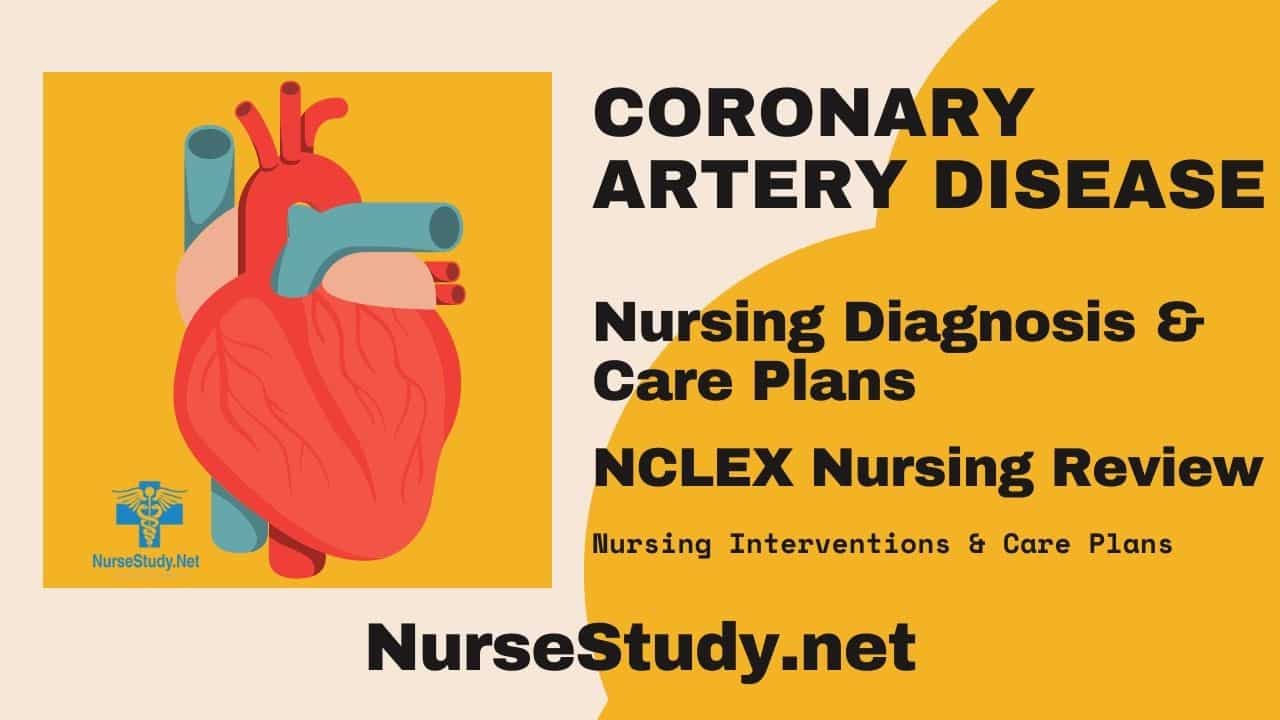Coronary Artery Disease occurs when the arteries supplying blood to the heart muscle become narrowed or blocked by plaque buildup (atherosclerosis). This restriction in blood flow can lead to various complications, including angina, myocardial infarction, and heart failure.
Key Clinical Manifestations
- Chest pain or pressure (angina)
- Shortness of breath (dyspnea)
- Fatigue
- Irregular heartbeat
- Dizziness
- Nausea
- Sweating
- Anxiety
Nursing Assessment for CAD
Primary Assessment Components
Health History
- Current symptoms
- Past cardiac events
- Family history
- Risk factors
- Current medications
- Lifestyle factors
Physical Assessment
- Vital signs
- Heart sounds
- Lung sounds
- Peripheral pulses
- Skin color and temperature
- Level of consciousness
- Signs of anxiety or distress
Diagnostic Studies
- ECG findings
- Cardiac enzymes
- Lipid profile
- Complete blood count
- Chest X-ray results
Essential Nursing Care Plans for CAD
1. Decreased Cardiac Output
Nursing Diagnosis Statement:
Decreased cardiac output related to reduced myocardial contractility and altered electrical conduction as evidenced by dysrhythmias, fatigue, and decreased ejection fraction.
Related Factors/Causes:
- Altered contractility
- Reduced coronary blood flow
- Electrical conduction abnormalities
- Structural changes in heart muscle
Nursing Interventions and Rationales:
Monitor vital signs and hemodynamic parameters q4h
- Rationale: Early detection of cardiovascular compromise
Assess for signs of decreased tissue perfusion
- Rationale: Identifies the need for immediate intervention
Position patient in semi-Fowler’s position
- Rationale: Reduces cardiac workload
Administer prescribed medications
- Rationale: Improves cardiac function and reduces symptoms
Desired Outcomes:
- The patient maintains stable vital signs
- Reports decreased fatigue
- Demonstrates improved activity tolerance
- Shows normal cardiac output parameters
2. Acute Pain
Nursing Diagnosis Statement:
Acute pain related to myocardial ischemia as evidenced by verbal reports of chest pain, facial grimacing, and autonomic responses.
Related Factors/Causes:
- Decreased myocardial oxygen supply
- Coronary artery spasm
- Increased cardiac workload
- Emotional stress
Nursing Interventions and Rationales:
Assess pain characteristics using PQRST method
- Rationale: Determines severity and appropriate interventions
Administer prescribed nitroglycerin and pain medications
- Rationale: Reduces myocardial oxygen demand
Monitor vital signs before and after pain medication
- Rationale: Evaluates treatment effectiveness
Provide a quiet, restful environment
- Rationale: Reduces oxygen demand and anxiety
Desired Outcomes:
- Reports pain reduction to 2/10 or less
- Demonstrates understanding of pain management
- Identifies pain triggers
- Uses appropriate pain management strategies
3. Activity Intolerance
Nursing Diagnosis Statement:
Activity intolerance related to imbalance between oxygen supply and demand as evidenced by dyspnea on exertion and unusual fatigue with activity.
Related Factors/Causes:
- Reduced cardiac output
- Increased myocardial oxygen demand
- Sedentary lifestyle
- Generalized weakness
Nursing Interventions and Rationales:
Assess activity tolerance using a standardized scale
- Rationale: Establishes baseline and monitors progress
Plan activities with rest periods
- Rationale: Prevents overexertion
Implement a progressive activity program
- Rationale: Builds endurance safely
Monitor vital signs during activity
- Rationale: Ensures safe activity levels
Desired Outcomes:
- Participates in the prescribed activity program
- Reports decreased fatigue with activity
- Demonstrates improved exercise tolerance
- Maintains stable vital signs during activity
4. Anxiety
Nursing Diagnosis Statement:
Anxiety related to threat to health status as evidenced by expressed concerns, restlessness, and increased vital signs.
Related Factors/Causes:
- Uncertainty about prognosis
- Fear of death
- Change in health status
- Knowledge deficit
Nursing Interventions and Rationales:
Assess anxiety level using a standardized scale
- Rationale: Establishes baseline and monitors progress
Provide clear, concise information
- Rationale: Reduces fear of the unknown
Teach relaxation techniques
- Rationale: Promotes stress management
Include family in care planning
- Rationale: Enhances support system
Desired Outcomes:
- Verbalizes decreased anxiety
- Uses effective coping strategies
- Demonstrates relaxation techniques
- Shows stable vital signs
5. Risk for Ineffective Self-Management
Nursing Diagnosis Statement:
Risk for ineffective self-management related to complexity of therapeutic regimen and insufficient knowledge of disease management.
Related Factors/Causes:
- Complex medication regimen
- Lifestyle modification requirements
- Limited understanding of the disease process
- Inadequate support system
Nursing Interventions and Rationales:
Assess the patient’s understanding of the disease process
- Rationale: Identifies knowledge gaps
Provide comprehensive education
- Rationale: Promotes self-management skills
Develop an individualized action plan
- Rationale: Enhances compliance
Connect with community resources
- Rationale: Provides ongoing support
Desired Outcomes:
- Demonstrates understanding of disease process
- Follows the prescribed treatment plan
- Identifies warning signs requiring medical attention
- Uses appropriate resources for support
Patient Education and Discharge Planning
- Medication management
- Lifestyle modifications
- Risk factor control
- Activity guidelines
- Follow-up care
- Emergency action plan
References
- Smith, J., & Johnson, B. (2023). Current Approaches to Nursing Care in Coronary Artery Disease. Journal of Cardiovascular Nursing, 38(2), 112-124.
- Anderson, R.M., et al. (2023). Evidence-Based Nursing Interventions for Cardiac Patients. American Journal of Nursing, 123(4), 45-52.
- Williams, P.K., & Davis, S.L. (2023). Nursing Diagnosis in Cardiovascular Care: A Systematic Review. Heart & Lung, 52(1), 23-31.
- Brown, M.A., et al. (2023). Clinical Outcomes in CAD: Impact of Nursing Interventions. Cardiology Nursing Quarterly, 46(3), 178-189.
- Thompson, C.R., & Garcia, R.N. (2023). Best Practices in Cardiac Nursing Care. Critical Care Nursing Clinics, 35(2), 67-79.
- Martinez, L.K., & Lee, S.H. (2023). Patient Education Strategies in Coronary Artery Disease Management. Patient Education and Counseling, 106(4), 890-901.
